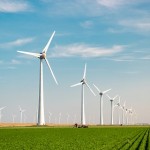Europe’s push for renewable energy at the cost of conventional fuel may end up causing a global food crisis. Since August 2021, Western Europe has faced a problem with renewable energy – the wind doesn’t always blow when needed and sun doesn’t always shine. Countries such as U.K., Spain and Germany are relying more on natural gas to make up the electricity shortfall, causing a crisis that will be felt worldwide.
Rich West European nations have been the most enthusiastic proponents of ‘green’ energy, shutting down coal and nuclear power plants to shift to solar and wind energy wholesale.
What happens when renewable energy doesn’t deliver the goods, and rich economies scramble to buy gas to make up the shortfall? The world is discovering now. Commodity markets across the world operate on a balance of demand and supply – even seemingly ‘small’ changes in either side of a few percentage points can push the prices up or down sharply. Europe’s sudden appetite for natural gas has pushed up the prices of Liquefied Natural Gas (LNG), the form in which gas gets traded globally. LNG price published by the Australian Competition & Consumer Commission (Australia is one of the leading global LNG exporters) is at US $30/mmbtu in January 2022 – versus a long term average of $7-8/mmbtu[1]. Higher gas prices have pushed up energy bills for households and are expected to impact household spending and consumption as well[2].
The sudden dependence on natural gas during winter has also made European countries wary of upsetting Russia – which has amassed troops at the Ukrainian border. Some European observers are blaming Russia for the high gas prices and for using its gas supplies as geopolitical leverage – the actual cause of the problem is underinvestment by European governments in reliable energy sources.
Natural gas is an input used to produce urea – if gas prices go up, fertiliser also becomes expensive. Urea prices are about 3X the level of where they were one year ago[3]. More expensive fertiliser is going to mean more expensive food – which will disproportionately hurt the world’s poor. The Food and Agricultural Organization (FAO) food price index is already at a 10-year high[4]. Some poor and middle income countries are already starting to face problems of fertiliser availability[5], including reports from several Indian states as well[6] [7] [8]. The impact of expensive fertiliser will be felt some months down the line as expensive fertiliser and reduced harvests push up food prices. India is relatively less affected as the share of natural gas in the country’s energy mix is low but will still face problems due to high food prices. The food inflation will come at a time when the ongoing pandemic has disproportionately hurt the lower income groups worldwide.
This is not the first time either. During 2007-08, when oil prices were high, there was a push to use ‘biofuels’ led by the U.S. and Europe. Land was diverted to cultivate crops that could be converted to ethanol, leaving less for food crops. The effects of the 2008 food price crisis were felt around the world, especially by the poor[9]. High price of food was one of the proximate causes of political unrest in the Arab world in 2011 – Libya and Syria continue to feel its after effects.
A blind push to demonise and shut down traditional sources of energy and move to less reliable ‘clean’ energy can have second and third order effects, as is being discovered now. Europe is rich enough to be able to buy its way out of self-created problems, leaving others to deal with the consequences.
The crisis also holds lessons for India, which has ambitious plans for using renewable technologies but doesn’t have the financial cushion available to the European nations. Cheap and reliable energy sources should not be abandoned until the alternatives have been stringently stress tested. India will be especially hard hit if oil prices spike as it imports close to 1.4 billion barrels of oil annually. However, fresh investment in developing new oil and gas reserves has been slowing down globally, in part due to climate action – and crude oil price is at a multi-year high.
This blog was first published in The Indian Express.
Amit Bhandari is Senior Fellow, Energy, Investment and Connectivity Studies Programme, Gateway House.
References:
[1] https://www.accc.gov.au/regulated-infrastructure/energy/gas-inquiry-2017-2025/lng-netback-price-series
[2] https://www.reuters.com/business/energy/euro-zone-consumers-shock-power-bills-soar-2022-01-18/
[3] https://fertiliserindia.com/black-sea-urea-monthly-spot-price-december-2021/
[4] https://www.fao.org/worldfoodsituation/foodpricesindex/en/
[5] https://www.dawn.com/news/1670221/na-witnesses-heated-exchange-of-arguments-on-urea-shortage
[6] https://www.thehindu.com/news/national/kerala/a-crisis-year-for-paddy-farmers-in-palakkad/article38073039.ece
[7] https://en.gaonconnection.com/bihar-farmers-urea-shortage-fertilisers-supaul-rabi-crop-winter-season-sowing-agriculture-india/
[8] https://www.newsclick.in/Tamil-Nadu-Farmers-Blame-Centre-Shortage-High-Prices-Fertilisers
[9] https://www.worldbank.org/en/results/2013/04/11/global-food-crisis-response-program-results-profile


